
Bruising is a common condition that most people experience and can result from various causes, including accidents, falls, and sports injuries. It may seem like a minor injury, but if not properly managed, it can lead to severe pain, swelling, and even loss of function of the affected area. If you have a bruised hand, it's important to take the right steps to manage the injury and promote quick healing. In this blog post, we'll be discussing everything you need to know about managing a bruised hand.
1. Rest and Elevate Your Hand
Resting your hand is one of the most crucial steps in managing a bruised hand. You need to avoid any activities that could put more strain on the affected area, such as lifting heavy weights or using tools. It's also essential to elevate your hand above your heart level to reduce swelling and inflammation. To do this, you can prop your hand up using a pillow or cushion while lying down, or you can simply hang your hand over the edge of a chair while sitting up.
2. Ice the Affected Area
Another effective way to manage a bruised hand is by applying ice to the affected area. Ice helps to reduce swelling, numb the pain, and prevent further damage to the soft tissues. You can wrap some ice in a towel and apply it to the bruised area for about 15-20 minutes every few hours. Avoid placing ice directly on the skin as it can cause frostbite.
3. Apply Compression
Applying compression to the affected area can also help to reduce swelling and promote quick healing. You can use an elastic bandage or compression wrap to wrap around the bruised area, making sure not to wrap too tightly. A good rule of thumb is to wrap tight enough to provide support but not so tight that it cuts off circulation to the area.
4. Take Over-the-Counter Painkillers
In addition to the above steps, taking over-the-counter painkillers such as ibuprofen or acetaminophen can help relieve pain and reduce inflammation. Follow the recommended dosage on the label and don't take any other medication without consulting your doctor first.
5. Seek Medical Attention If Necessary
If your bruised hand is severe, or if you experience numbness or tingling, you should seek medical attention immediately. Your doctor may recommend further tests such as X-rays or an MRI to rule out any underlying injuries. If necessary, your doctor may refer you to an orthopedic surgeon for advanced treatment.
Conclusion
Managing a bruised hand is crucial to prevent further damage to your soft tissues and promote quick healing. Resting and elevating your hand, applying ice, using compression, taking over-the-counter painkillers, and seeking medical attention if necessary, are all essential steps in managing a bruised hand. Remember, if your bruised hand is severe or shows no improvement after a few days, you should contact your doctor immediately for further evaluation and treatment. If you're looking for an orthopedic surgeon in Deltona, FL, contact Central Florida Bone & Joint Institute today for more information.